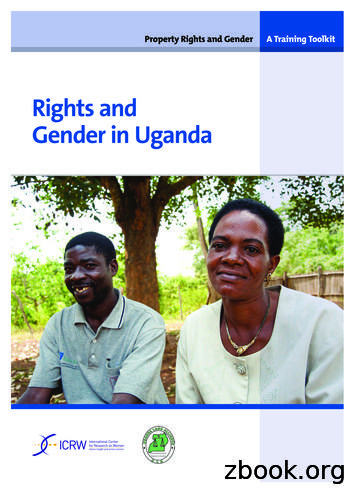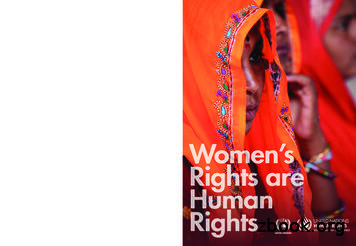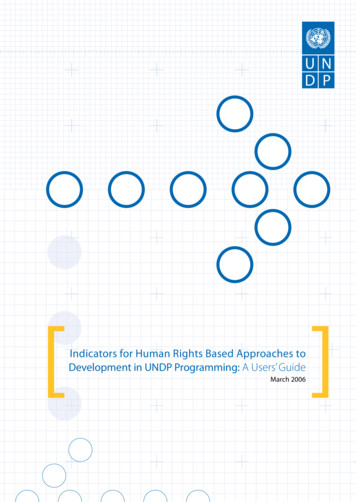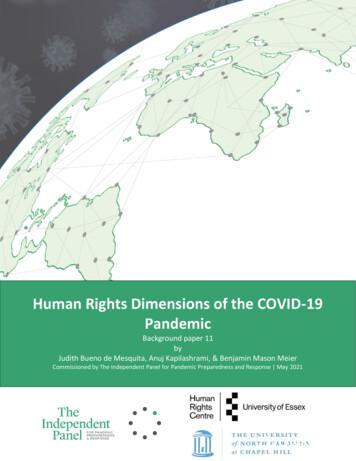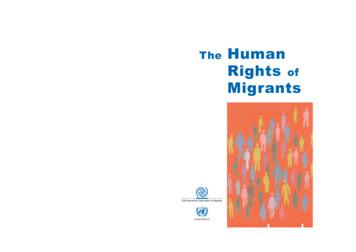HUMAN RIGHTS AND HISTORY - Menschenrechte
HUMAN RIGHTS AND HISTORYA CHALLENGE FOR EDUCATIONedited by Rainer Huhle
Foundation “Remembrance, Responsibility and Future”Stiftung “Erinnerung, Verantwortung und Zukunft”Lindenstraße 20–2510969 BerlinGermanyTel 49 (0) 30 25 92 97- 0Fax 49 (0) 30 25 92 -11info@stiftung-evz.dewww.stiftung-evz.deEditor: Rainer HuhleTranslation and Revision: Patricia SzobarCoordination: Christa MeyerProofreading: Julia Brooks and Steffi ArendseeTypesetting and Design: dakato design. David SernauPrinting: FATA Morgana VerlagISBN-13: 978-3-9810631-9-6Berlin, February 2010Photo Credits:Cover page, left:Stèphane Hessel at the conference “Rights, that make us Human Beings” in Nuremberg,November 2008. Foundation Remembrance, Responsibility and Future, photographerJan ZappnerCover page, center: United Nations International Nursery School, “It’s Human Rights Day for Them, Too,”Dec. 1, 1950. United Nations, NICA ID 123898Cover page, right: Europeans for Peace, photo archive
Human Rights and History:A Challenge for Educationedited by Rainer Huhle
Contents461119Foreword (Martin Salm)Introduction: The Complex Relationship of Historical Learning and Human Rights (Rainer Huhle)A Duty to Humanity – Stéphane Hessel (Interview with Rainer Huhle)Human Rights and Their History from a European Perspective (Morten Kjaerum)The Dawn of Human Rights2537The Universal Declaration and the Conscience of Humanity (Johannes Morsink)“Jewish Rights are Human Rights”: Jewish Contributions and Controversies in theInternational Establishment of Human Rights after 1945 (Rainer Huhle)5062From the Holocaust to the Genocide Convention: A Human Rights Learning Process (William Schabas)Coming to Terms with “Crimes against Humanity”: Nuremberg and Beyond (Rainer Huhle)Responses to the Experience of Injustice: Selected Examples829099107The Prohibition on Discrimination: A Founding Principle of Human Rights (Heiner Bielefeldt)Freedom of Expression as a Human Right: The Role of Hate Speech in the Public Sphere (Otto Böhm)Freedom of Expression as a Cornerstone Human Right (Agnès Callamard)The Right to Asylum in West Germany: Refugee Policies in the Federal Republic ofGermany, 1949–1975 (Patrice G. Poutrus)114125From Abolition to Eradication: Slavery in the Twenty-First Century (Aidan McQuade)Compensation for Nazi Slave Labor: The Context of Human Rights (Günter Saathoff)Human Rights Education as the Outcome of Human Rights Movements130142155“The Law is Our Only Language”: Soviet Dissidents and Human Rights (Uta Gerlant)the Colombian and Latin American Experience (Flor Alba Romero)The Helsinki Final Act and the Civil and Human Rights Movement in the Soviet Union (Ernst Wawra)Human Rights Education between Norms and Practice: Reflections onHistory and Human Rights Education166175The Role of History in Education against Discrimination (Monique Eckmann)Rights Education (Albert Scherr)180189Memory Work and Human Rights Education in an Immigrant Society (Hasko Zimmer)The Role of Historical and Political Education in Contemporary HumanHistory as Resource: Human Rights Education as Historical and Political Education (Karl-Peter Fritzsche)192 Index of AuthorsStiftung EVZHUMAN RIGHTS AND HISTORY: A CHALLENGE FOR EDUCATION
Stiftung EVZHUMAN RIGHTS AND HISTORY: A CHALLENGE FOR EDUCATION3
ForewordForewordWhen we met in November 2008 for the international conference “Rights that make us Human Beings,” wegathered at a historic location: the courtroom of the Nuremberg District Court, which was the setting for theNuremberg Trials from 1945 to 1949.Stéphane Hessel’s appearance there remains especially vivid in my memory. Hessel is a survivor of the Buchenwald concentration camp and French diplomat who participated in the drafting of the Universal Declaration of Human Rights. At this historic location, Hessel spoke about the challenges we face today. He passionately called on young people to work for a solution to an increasingly urgent problem, namely the scarcity ofresources and climate change, and especially for a solution to global poverty.In so doing, he touched on the overarching challenge that shaped the conference: to conceive of the humanrights formulated in 1948 as a direct response to war and genocide and as the product of history, and to relatethem to contemporary threats to human dignity. One of our central interests in this respect is human rightseducation, which always entails two things: conveying knowledge and respect for human rights. The link between knowledge and attitudes is important because knowledge alone cannot produce action to protect human rights, just as an opinion without knowledge cannot ground arguments or produce useful action over thelong term.The Foundation “Remembrance, Responsibility and Future” stands for the acceptance of responsibility forpast injustices and, against this background, for resisting the threat of new injustices. This relationship between historical awareness and current engagement remains fragile. Awareness of the historical genesis ofhuman rights is part of the understanding of these rights, yet we also know that human rights have a universalvalidity independent of their original context. By the same token, a human rights perspective on historicalinjustice helps us move beyond ideology or other prejudices, but commemoration and mourning also requirea space that is not necessarily oriented towards current engagement.One of the central concerns of this volume is to situate the United Nations Charter of Human Rights and itsprovisions within their historical context. The Foundation “Remembrance, Responsibility and Future” embodies the desire to link our efforts to facilitate understanding between peoples to the historical experience ofinjustice, and to realize this project by promoting human rights education that takes historical contexts intoaccount. If we learn about rights in their proper historical context, we are better equipped to understand injustice in the present day, and we come to understand the need to struggle against violations of human rights,to demonstrate civic courage, and to draw sustenance from our successes. We also learn that our engagementfor human rights is an open-ended struggle, with a history of achievement and ongoing challenges.This volume is the outcome of papers given at the 2008 conference in Nuremberg, and of our subsequent discussions and reflections. I extend my sincere gratitude to the editor Rainer Huhle, the individual authors, thetranslator Patricia Szobar and our program manager Christa Meyer.Martin SalmChairman of the Foundation “Remembrance, Responsibility and Future”4Stiftung EVZHUMAN RIGHTS AND HISTORY: A CHALLENGE FOR EDUCATION
Stiftung EVZHUMAN RIGHTS AND HISTORY: A CHALLENGE FOR EDUCATION5
Rainer HuhleIntroduction: TheComplex Relationship ofHistorical Learning andHuman RightsOn December 10, 2008, the 60th anniversary of the Universal Declaration of Human Rights (UDHR) was celebrated around the world. The anniversary occasioned many publications, conferences and other events thataddressed the development and significance of the Declaration and the enforcement of the human rights thatit envisions. Once again, it became clear that people throughout the world regard the Declaration, with itsstraightforward prose that has been translated into countless languages, as a binding statement of their human rights.The Foundation “Remembrance, Responsibility and Future” and the Nuremberg Human Rights Center usedthe anniversary as an impetus to explore a very special aspect of the Universal Declaration, namely its significance for human rights education. In particular, we addressed the tension between concrete experiencesof injustice, as they are reflected in the history of the development of the Declaration, and the pursuit ofuniversal, normative human rights that are temporally and spatially decontextualized. This tension stemsfrom the UDHR’s status as a historical and temporally bound document that is imbued with both universaland contemporary meaning. Drafted at a time when the recognition of human rights was a direct response tothe crimes of Nazi Germany, the Declaration provided universal answers to concrete experiences of injusticethat remain valid today.The 1948 Universal Declaration therefore forms an important link between human rights education and historical learning. Against the background of historical experiences of different nations and cultures – for example the crimes committed in and by Nazi Germany, the genocide of the Jews, and the history of the Communist dictatorships of Central and Eastern Europe – we see how human rights can be created, recognized,understood and later implemented as a universal answer to concrete injustice. At the same time, humanrights embody the ideals and actions of all those who tried to protect the dignity and rights of humans evenin periods of injustice.Although the Nazi era is unique in its radical denial of certain humans as subjects and its organized mass murder, the historical response to Nazism in the form of human rights remains valid today. Even today, peoplein nations across the world respond to injustices they have experienced by invoking their inalienable rights,which are guaranteed by the UDHR, by universal and regional human rights treaties, and in the basic rightsenumerated in national constitutions. Here too, individuals struggle courageously against violence, oppression and exploitation under the banner of human rights.6Stiftung EVZHUMAN RIGHTS AND HISTORY: A CHALLENGE FOR EDUCATION
Introduction: The Complex Relationship of Historical Learning and Human RightThe tension between uniquely dramatic experiences and the effort to achieve a universal human rights response was the central theme of the conference organized by the Foundation “Remembrance, Responsibility and Future” and the Nuremberg Human Rights Center in Nuremberg in November 2008.1 This volumecontains papers presented and discussed at the conference, as well as additional chapters by other authors.The volume is the continuation of a compelling debate that has inaugurated a new sphere of action for theorganizations represented at the conference.After the horrific experience of the crimes of National Socialism, the scope of which gradually became apparent after the end of the war, a broad universal consensus developed – beginning at the United Nations conference convened in April 1945 in San Francisco – on the need to implement three steps:·furthering the normative development of human rights, initially reflected above all in the UN Charterand the UDHR, as a response to the trauma of the “barbarous acts” committed under National Social-ism (as cited in the preamble to the UDHR), and other contemporary historical experiences of injustice;·capturing the specific crime of the Holocaust under a new universal definition of genocide, as it wassubsequently formulated in the 1948 Convention on the Prevention and Punishment of the Crime ofGenocide, which was the first international agreement for the protection of human rights;·the elaboration of international criminal law and establishment of corresponding internationalcriminal courts to adjudicate such human rights violations in the future. The Nuremberg Trials formthe basis for a universal criminal court procedure.The contributions in the first section of this volume elucidate these processes. Stéphane Hessel embodies likefew others of his generation the step from the experience of suffering under National Socialism to constructive and forward-looking solutions. Born in Germany and raised in France, Hessel joined the French Resistance and survived three Nazi concentration camps. After the war, he joined the French diplomatic service,where he continued to work on behalf of human rights, international cooperation and international socialjustice. His words of encouragement profoundly affected the Nuremberg conference participants. An interview with Stéphane Hessel opens this volume.In the first section of this volume, Johannes Morsink not only shows how profoundly the crimes of NationalSocialism affected participants in this debate, who came to the conference from across the globe, but alsoargues that this trauma represented a necessary precondition for an agreement on the formulation of human rights. According to Morsink, the universal human capacity to feel repulsed by injustice is a necessaryprecondition for the articulation of human rights. Rainer Huhle investigates the question whether we candetect specifically Jewish positions in the codification of human rights after 1945 in light of the unprecedentedcrime of the Holocaust. His conclusion, which is surprising only at first glance, is that the many Jewish contributions to the debate on the establishment of a new human rights order after 1945 occurred within andnot outside the broader currents of the time and enriched the discussion in many different ways. WilliamSchabas examines the 1948 Convention on the Prevention and Punishment of the Crime of Genocide, whichwas adopted by the United Nations General Assembly at the same time as the Universal Declaration, and its“founding father” Raphael Lemkin, to describe the complex and often contradictory path from specific historical experiences to the development of a universally valid norm for the crime of genocide. One of the manyissues that had to be solved at the time was the conceptual distinction between genocide and crimes againsthumanity or war crimes. The International Military Tribunal at Nuremberg was not prepared to name andprosecute Nazi crimes according to a sustainable human rights perspective. Instead, the Allies clung to the1 See also the conference report at http://www.konferenz-nuernberg08.de/?lang en.Stiftung EVZHUMAN RIGHTS AND HISTORY: A CHALLENGE FOR EDUCATION7
Rainer Huhleestablished norms of the laws of war, in spite of the fact that the charge of “crimes against humanity” wouldno longer have required an association with war. William Schabas’ analysis of the concept of genocide andRainer Huhle’s discussion of crimes against humanity both explore how these most serious crimes came tobe defined despite numerous obstacles outside the context of war. This definition paved the way towardsa universal international criminal law for crimes against humanity, which was ultimately anchored in theInternational Criminal Court.In the second section of this volume, the authors examine specific human rights and how their formulationwas shaped by different historical experiences and legal traditions. The basis for the development of humanrights is the prohibition on discrimination that is so forcefully articulated in the Universal Declaration. Its firsttwo articles postulate the same rights for all humans, while the remaining articles delineate rights for “all” orfor “everyone.” Heiner Bielefeldt elucidates the historical contours and contemporary challenges of the prohibition on discrimination as the fundamental principle of human rights. The prohibition was understood asthe most basic human right – in contrast to the extreme racial discrimination of Nazi Germany – because it isthe fundamental precondition for all other human rights. At the same time, the elaboration of this prohibitionis especially complex because discrimination has always and continues to take on new forms. For example,agreements that are reached today regarding discrimination on the basis of disability or sexual orientationdemonstrate that the learning process did not end in 1948. Rather they show that the experiences of affectedgroups can continually expand and concretize the prohibition against discrimination. Indeed, it could be argued that the formulation of every human right, particularly after 1945, derived from concrete experiences ofinjustice. The contributions in this volume consider only three of many possible examples.The right to the free expression of opinion is one of the classic freedoms that took shape early in the history ofhuman rights in the West. In the wake of the National Socialist repression of all oppositional expression (andin the wake of Stalinist repression), the UDHR redefined freedom of expression with particular emphasis. Theconcise formulation of Article 19 of the UDHR masks the many heated debates that took place both inside andoutside the Commission on Human Rights in the postwar years. The experience of National Socialism not onlysuggested the lesson that freedom of expression was a fundamental right for the preservation of democracy,but also that it might be necessary to prevent the expression of pro-fascist opinions. This tension, which isalso reflected in Articles 19 and 29 of the UDHR, characterizes the elaboration of the right of freedom of opinion and information even today, and has been expressed in a multiple ways within different legal contextsand cultures. Agnès Callamard and Otto Böhm examine the scope and limits of freedom of expression fromtwo different perspectives. Although the emphasis of their essays is different, they arrive at complementaryconclusions.When human rights were elaborated after the war, nations across the world were experiencing a refugee crisis.Millions of these refugees were not only homeless, but stateless. The dramatic events surrounding the victimsof National Socialism, who were unable to obtain refuge abroad, were still vivid in international memory. Thisresulted in the formulation of a completely new human right, the “right to asylum.” Upon closer examination,the right to asylum as defined in Article 14 of the UDHR is quite modest in scope, entailing only the “right toseek and to enjoy in other countries asylum from persecution.” Even in 1948, no state was prepared to acceptan outright obligation to admit political refugees to its territory. An additional difficulty is that no legal bodyexisted that could have monitored such an international law. By its very nature, the right to asylum had tobe formulated as a national right. This is what happened in Germany, the country that had been the startingpoint for the global refugee crisis. In Germany, the Basic Law of 1949 included the article “Persons persecuted8Stiftung EVZHUMAN RIGHTS AND HISTORY: A CHALLENGE FOR EDUCATION
Introduction: The Complex Relationship of Historical Learning and Human Righton political grounds shall have the right of asylum.”2 In his essay, Patrice G. Poutrus details the rather meagerpractical effect this clear-cut provision had even during the early years of the West German state, well beforeArticle 16 of the Basic Law was amended and adapted to the developments of realpolitik. For its part, the 1951Geneva Convention Relating to the Status of Refugees referred explicitly only to refugees from the SecondWorld War and made no provisions for future refugees, which further highlights the limitations of the humanrights lessons that were drawn from the barbaric history of fascism and the war.The oldest still active human rights movement is the movement for the abolition of slavery and the slave trade.Aidan McQuade, director of the organization Anti-Slavery International, shows that the history of slavery didnot end with abolition. To the contrary, he argues that the distressing diversity of new forms of slavery in the21st century is an “open secret of the globalizing political economy.” In the anti-slavery movement, learningfrom history above all encompasses the ability to recognize how the forcible exploitation of humans for animmense variety of purposes continues to assume new forms. Under National Socialism, slavery reached ahorrific highpoint in the brutal forced labor of millions of people. For many years, however, the former forcedlaborers received scant international attention. The Foundation “Remembrance, Responsibility and Future”is the belated culmination of years of struggle on behalf of surviving forced laborers and their representatives to shed light on their experiences and suffering and receive at least symbolic compensation. In his essay,Günter Saathoff, a member of the board of directors of the Foundation, examines the history of this belatedlearning process that was driven by the Federal Republic of Germany together with international organizations. Saathoff also illuminates the legal and political limits of these efforts.If the formulation of human rights always derives from specific historical experiences of injustice, who arethe agents of this learning process? The incipient global human rights movement after the Second World Warwas multifaceted and heterogeneous in its composition. Many different civic groups crafted the human rightsagenda and tried to realize its goals, but as Johannes Morsink shows, human rights also deeply penetrated thespheres of politics and diplomacy. After a long period of stagnation, human rights agreements were revivedin many different regions during the 1970s as a result of popular movements against repressive regimes. Thisvolume considers two important points of focus for these new human rights movements. Uta Gerlant andErnst Wawra both consider the Helsinki movement in Central and Eastern Europe, which was inspired by theFinal Act of the Conference on Security and Cooperation in Europe. The result of years of diplomatic negotiations, the Final Act was initially accorded little significance. The groups that referenced the Final Act as thebasis for elaborating concrete human rights demands also demonstrate that human rights rhetoric carries acost. Indeed, the rhetoric may be taken quite seriously, as the governments of Eastern Bloc nations eventuallydiscovered.The same holds true for Latin America, which was dominated by violent military dictatorships during the1970s. After General Augusto Pinochet’s 1973 coup d’état in Chile, a human rights movement began to develop across the continent that for the first time struggled to realize the human rights principles enshrined inUN agreements and inter-American human rights declarations and agreements. As in Central and Eastern Europe, an intensive learning process took place within the Latin American human rights movement regardingthe potential for human rights action against political repression. This learning process also led to an intensive teaching process, as Flor Alba Romero demonstrates with the example of Colombia. Across much of LatinAmerica, human rights education was seen as a weapon against the regimes that routinely violated human2 Press and Information Office of the Federal Republic of Germany, Basic Law of the Federal Republic of Germany, promulgated by the ParliamentaryCouncil on May 23, 1949.Stiftung EVZHUMAN RIGHTS AND HISTORY: A CHALLENGE FOR EDUCATION9
Rainer Huhlerights. Although human rights education had been on the United Nations agenda since 1948, its global revivaland the enrichment of its methodologies and concepts has emerged largely from this new impetus from LatinAmerica. Thus, both the formulation of human rights norms and human rights education stem from concreteexperiences of injustice. These experiences require actors – individuals, groups and movements – to articulate them.The final section of this volume raises the issue of the role of historical experience and historical educationin human rights education. The individuals and organizations involved in the historical development of themodern concept of human rights after 1945 always understood that development as a learning process. Examining this postwar learning process helps us better understand the relationship between concepts of historyand concepts of human rights, and the relationship between historical learning and human rights educationtoday. The history of the promulgation of the Universal Declaration and the history of national experiences ofinjustice are particularly fruitful entry points for historically grounded human rights education, as well as forhistorical education that incorporates issues of human rights.In the opening essay of this section, Monique Eckmann analyzes historically grounded human rights education by focusing on the central element of the Universal Declaration, the right to be protected from discrimination. Eckmann considers both historically grounded and ahistorical models of anti-discriminationeducation (especially Holocaust education) to argue for an approach that bridges historical and contemporaryexperiences of discrimination and, as a result, bridges personal experience and experiences shared with otherindividuals and groups. Hasko Zimmer explores the challenges posed by human rights education for societiesthat are increasingly shaped by immigration, particularly among their younger generation. In Germany, thesechallenges are felt especially acutely in human rights education on the topics of National Socialism and theHolocaust. In the process, Zimmer warns against the tendency of majority groups to dominate the framingand interpretation of historical and human rights education. According to Zimmer, the inherent diversity ofthe experiences of human rights violations serves as the impetus for new articulations of human rights. Recognizing this diversity of experience thus allows us to understand human rights as the outcome of a process ofstruggle, both in the past and today. Albert Scherr also emphasizes the usefulness of historical relationships– with an emphasis on “relationships” in the plural – to effective human rights education. If we wish to avoidteaching human rights as ahistorical dogma, our educational efforts must incorporate the complex and oftencontradictory history of the social movements that helped shape human rights across the centuries as theypaved the way for the overarching consensus achieved in the 1948 Universal Declaration. Incorporating thiscomplex history is essential to creating an effective human rights engagement that avoids moralizing arguments. In the final contribution, K. Peter Fritzsche takes up many of the arguments presented by the authorsof this volume to propose ten concise theses for historically grounded human rights education as the foundation for further discussion and debate among theorists and practitioners in the field.In light of these historical examples of concepts of human rights education in social movements and the findings of the Nuremberg conference on topics ranging from the prohibition against discrimination and tortureto the freedom of religion, political participation, expression, and information, we must ultimately examinethe relevance of our knowledge of historical experiences of injustice and the development of human rights inresponse to these experiences for contemporary educational work. The question remains what lessons thishistory provides for the complex relationship of human rights education and the active struggle to enforcehuman rights.10Stiftung EVZHUMAN RIGHTS AND HISTORY: A CHALLENGE FOR EDUCATION
INTERVIEW WITHSTÉPHANE HESSELThe son of writer Franz Hessel, Stéphane Hessel was born in Berlin in 1917. In 1924, he and his parentsmoved to Paris. He became a French citizen in 1937, and began studying philosophy at the École NormaleSupérieure. After joining Charles de Gaulle’s Free French Forces, Hessel went to London in 1941 and returned to France as an agent. In July 1944, he was arrested by the Gestapo, tortured and deported to Buchenwald. Hessel was able to escape execution by exchanging identities with a comrade who perished in thecamp and was later transferred to the Rottleberode and Dora concentration camps. When the Dora campwas evacuated in advance of the approaching Allied troops, Hessel finally succeeded in escaping from thetransport train. Immediately after the end of the Second World War, Hessel joined the French diplomaticservice, where his career included postings to the United Nations and to several North African nations.Rainer Huhle interviewed Stéphane Hessel at his home in March 2009. The interview was conducted inGerman. The footnotes are by Rainer Huhle.Rainer Huhle: In your book, you wrote that you became a diplomat as a result of your experience of the concentration camp. I found that quite surprising, since it’s hard to imagine Buchenwald and Dora as the motivation for a diplomatic career. Could you elaborate on this a bit?Stéphane Hessel: Two different factors played a role. On the one hand, many different nations were represented at Buchenwald. People from all over Europe were interned there, and we had a sense that togetherwe needed to achieve something larger than that terrible concentration camp. There were also Germans atBuchenwald, and in fact the first inmates at Buchenwald were German. In the camps, it seemed that when wesucceeded in speaking with each other – which wasn’t always easy – we discovered that we all shared the sameexperience, the experience of suddenly being swept away by the horrifying wave of Nazi terror. So the concentration camp prompted my earliest identification with an international perspective. That was where I firstassumed an international outlook, and the camps were responsible for awakening my interest in diplomacy.On the other hand, I lived through one of the longest wars. I enlisted in the French army in 1939, and I wasn’t atliberty again until May 1945 – six years later. After that long experience of war, I decided to abandon scholarship, to leave the École Normale and philosophy, and instead work on something I found personally meaningful, something in an international field. “Diplomat” is of course a complex term. In a sense, a diplomat strivesStiftung EVZHUMAN RIGHTS AND HISTORY: A CHALLENGE FOR EDUCATION11
Rainer Huhleto remain aloof from direct action. But on the other hand, after that terrible war, it seemed to me that refusingto take part in international relations would mean remaining on the sidelines. As Frenchmen, we are naturally interested in what is happening in France, but we also need to remain engaged with what is happ
human rights is part of the understanding of these rights, yet we also know that human rights have a universal validity independent of their original context. By the same token, a human rights perspective on historical injustice helps us move beyond ideology or other prejudices, but commemoration and mourning also require
Rights and gendeR in Uganda · 3 Rights & Human Rights Background Rights The law is based on the notion of rights. Community rights workers need to understand what rights are, where rights come from, and their own role in protecting and promoting rights. Community rights worker
A Human Rights Perspective by David Shiman Raising Children with Roots, Rights and Responsibilities: Celebrating the UN Convention on the Rights of the Child by Lori DuPont, Joanne Foley, and Annette Gagliardi Lesbian, Gay, Bisexual, and Transgender Rights: A Human Rights Perspective by David M. Donahue The Human Rights Education Handbook:
make up the International Bill of Human Rights. The provisions of the two Covenants, as well as other human rights treaties, are legally binding on . of their human rights, for example marriage and the family. 6 WOMEN’S RiGHTS ARE HUMAN RiGHTS The Convention defines d
stream human rights into development projects and to monitor and implement a human rights-based approach (HRBA) to development more generally. From the side of human rights, the demand has come from recognition among the human rights treaty monitoring bodies, the Office of the High Commissioner for Human Rights, and a variety of Special .
human rights impact of COVID-19 and COVID-19 responses on human rights; the role of global health and human rights governance actors, including the WHO, World Health Assembly, Office of the High Commissioner for Human Rights and UN human rights oversight bodies, suggesting areas of action for
consider the human rights dimension of contemporary migration. Under the Universal Declaration of Human Rights (created fifty years ago), human rights are universal (they apply everywhere), indivisible (political and civil rights cannot be separated from social and cultural rights); and inalienable (they cannot be denied to any human beings).
the concept of human rights, this essay will examine the tensions between human rights and state sovereignty, the challenges to the universality of human rights, the enumeration of rights recognized by the international community, and the means available to translate the high aspirations of human rights into practice. II.
C is much more flexible than other high-level programming languages: C is a structured language. C is a relatively small language. C has very loose data typing. C easily supports low-level bit-wise data manipulation. C is sometimes referred to as a “high-level assembly language”. When compared to assembly language .

